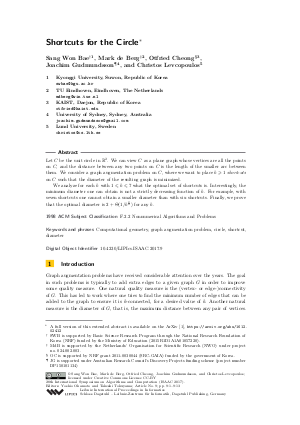Shortcuts for the Circle
Authors Sang Won Bae, Mark de Berg, Otfried Cheong, Joachim Gudmundsson, Christos Levcopoulos
-
Part of:
Volume:
28th International Symposium on Algorithms and Computation (ISAAC 2017)
Part of: Series: Leibniz International Proceedings in Informatics (LIPIcs)
Part of: Conference: International Symposium on Algorithms and Computation (ISAAC) - License:
 Creative Commons Attribution 3.0 Unported license
Creative Commons Attribution 3.0 Unported license
- Publication Date: 2017-12-07
File

PDF
LIPIcs.ISAAC.2017.9.pdf
- Filesize: 0.77 MB
- 13 pages
Document Identifiers
Subject Classification
Keywords
- Computational geometry
- graph augmentation problem
- circle
- shortcut
- diameter
Metrics
- Access Statistics
-
Total Accesses (updated on a weekly basis)
0PDF Downloads0Metadata Views
Abstract
Let C be the unit circle in R^2. We can view C as a plane graph whose vertices are all the points on C, and the distance between any two points on C is the length of the smaller arc between them. We consider a graph augmentation problem on C, where we want to place k >= 1 shortcuts on C such that the diameter of the resulting graph is minimized. We analyze for each k with 1 <= k <= 7 what the optimal set of shortcuts is. Interestingly, the minimum diameter one can obtain is not a strictly decreasing function of k. For example, with seven shortcuts one cannot obtain a smaller diameter than with six shortcuts. Finally, we prove that the optimal diameter is 2 + Theta(1/k^(2/3)) for any k.
Cite As Get BibTex
Sang Won Bae, Mark de Berg, Otfried Cheong, Joachim Gudmundsson, and Christos Levcopoulos. Shortcuts for the Circle. In 28th International Symposium on Algorithms and Computation (ISAAC 2017). Leibniz International Proceedings in Informatics (LIPIcs), Volume 92, pp. 9:1-9:13, Schloss Dagstuhl – Leibniz-Zentrum für Informatik (2017)
https://doi.org/10.4230/LIPIcs.ISAAC.2017.9
BibTex
@InProceedings{bae_et_al:LIPIcs.ISAAC.2017.9,
author = {Bae, Sang Won and de Berg, Mark and Cheong, Otfried and Gudmundsson, Joachim and Levcopoulos, Christos},
title = {{Shortcuts for the Circle}},
booktitle = {28th International Symposium on Algorithms and Computation (ISAAC 2017)},
pages = {9:1--9:13},
series = {Leibniz International Proceedings in Informatics (LIPIcs)},
ISBN = {978-3-95977-054-5},
ISSN = {1868-8969},
year = {2017},
volume = {92},
editor = {Okamoto, Yoshio and Tokuyama, Takeshi},
publisher = {Schloss Dagstuhl -- Leibniz-Zentrum f{\"u}r Informatik},
address = {Dagstuhl, Germany},
URL = {https://drops.dagstuhl.de/entities/document/10.4230/LIPIcs.ISAAC.2017.9},
URN = {urn:nbn:de:0030-drops-82133},
doi = {10.4230/LIPIcs.ISAAC.2017.9},
annote = {Keywords: Computational geometry, graph augmentation problem, circle, shortcut, diameter}
}
Author Details
References
- S. W. Bae, M. de Berg, O. Cheong, J. Gudmundsson, and C. Levcopoulos. Shortcuts for the Circle, 2016. URL: http://arxiv.org/abs/1612.02412.
-
D. Bilò, L. Gualà, and G. Proietti. Improved approximability and non-approximability results for graph diameter decreasing problems. Theoretical Computer Science, 417:12-22, 2012.

- J. Cáceres, D. Garijo, A. González, A. Márquez, M. L. Puertas, and P. Ribeiro. Shortcut sets for plane Euclidean networks (extended abstract). Electronic Notes in Discrete Mathematics, 54:163-168, 2016. URL: http://dx.doi.org/10.1016/j.endm.2016.09.029.
- J.-L. De Carufel, C. Grimm, A. Maheshwari, and M. Smid. Minimizing the Continuous Diameter when Augmenting Paths and Cycles with Shortcuts. In 15th Scandinavian Symposium and Workshops on Algorithm Theory (SWAT 2016), volume 53 of Leibniz International Proceedings in Informatics (LIPIcs), pages 27:1-27:14, 2016. URL: http://dx.doi.org/10.4230/LIPIcs.SWAT.2016.1.
-
F. R. K. Chung. Diameters of graphs: old problems and new results. Congressus Numerantium, 60:295-317, 1987.

-
F. R. K. Chung and M. R. Garey. Diameter bounds for altered graphs. Journal of Graph Theory, 8:511-534, 1984.

-
P. Erdös and A. Rényi. On a problem in the theory of graphs (in Hungarian). Publications of the Mathematical Institute of the Hungarian Academy of Sciences, 7:623-641, 1962.

-
P. Erdös, A. Rényi, and V. T. Sós. On a problem of graph theory. Studia Scientarium Mathematicarum Hungar, 1:215-235, 1966.

-
F. Frati, S. Gaspers, J. Gudmundsson, and L. Mathieson. Augmenting graphs to minimize the diameter. Algorithmica, 72(4):995-1010, 2015.

-
U. Große, J. Gudmundsson, C. Knauer, M. Smid, and F. Stehn. Fast algorithms for diameter-optimally augmenting paths. In 42nd International Colloquium Automata, Languages, and Programming (ICALP), pages 678-688. Springer, 2015.

-
S. Kapoor and M. Sarwat. Bounded-diameter minimum-cost graph problems. Theory of Computing Systems, 41(4):779-794, 2007.

-
C. L. Li, S. T. McCormick, and D. Simchi-Levi. On the minimum-cardinality-bounded-diameter and the bounded-cardinality-minimum-diameter edge addition problems. Operation Research Letters, 11(5):303-308, 1992.

-
A. A. Schoone, H. L. Bodlaender, and J. van Leeuwen. Diameter increase caused by edge deletion. Journal of Graph Theory, 11:409-427, 1987.

- H. Wang. An improved algorithm for diameter-optimally augmenting paths in a metric space, 2016. URL: http://arxiv.org/abs/1608.04456.
- B. Yang. Euclidean chains and their shortcuts. Theoretical Computer Science, 497:55-67, 2013. URL: http://dx.doi.org/10.1016/j.tcs.2012.03.021.
